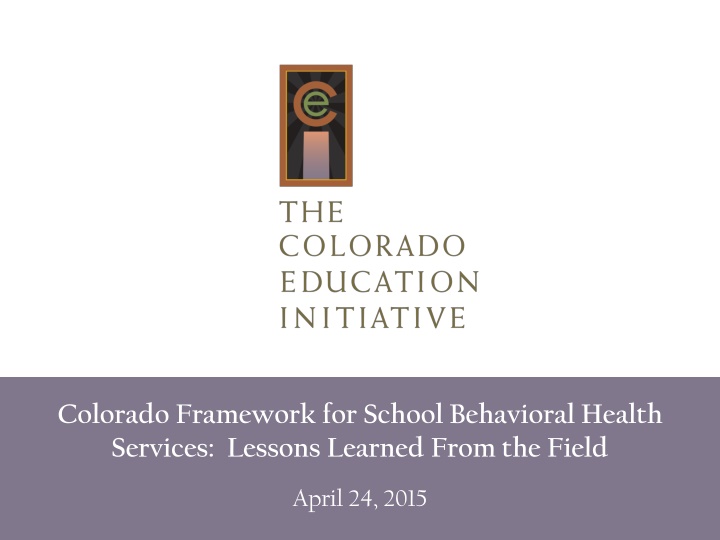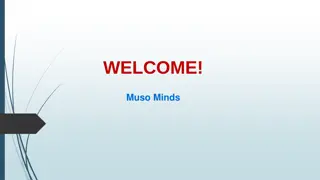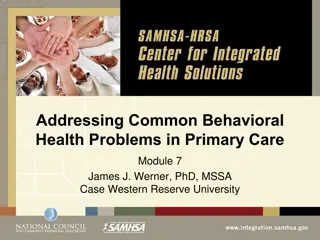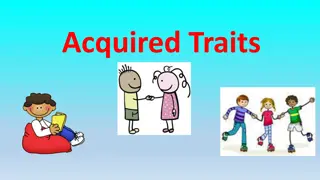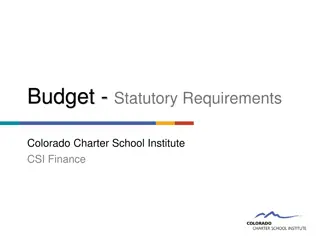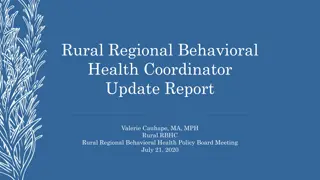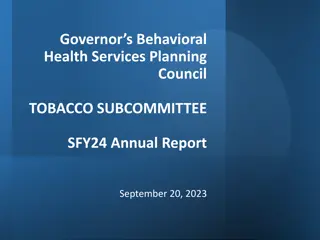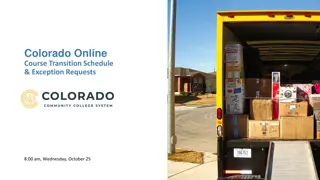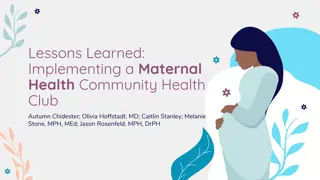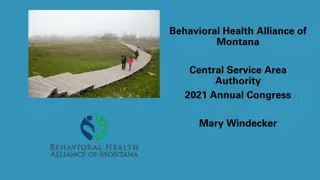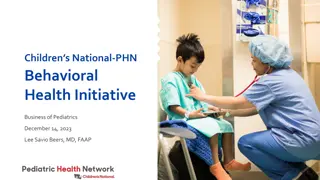Lessons Learned From Colorado Framework for School Behavioral Health
The Colorado Framework for School Behavioral Health Services highlights the significant impact of social, emotional, and behavioral health on academic achievement. Research emphasizes the connection between mental health and academic success, underscoring the importance of providing services and prevention within school settings. The framework aims to enhance support systems for students to improve outcomes by addressing gaps and barriers identified through research and consultation with experts.
Download Presentation

Please find below an Image/Link to download the presentation.
The content on the website is provided AS IS for your information and personal use only. It may not be sold, licensed, or shared on other websites without obtaining consent from the author.If you encounter any issues during the download, it is possible that the publisher has removed the file from their server.
You are allowed to download the files provided on this website for personal or commercial use, subject to the condition that they are used lawfully. All files are the property of their respective owners.
The content on the website is provided AS IS for your information and personal use only. It may not be sold, licensed, or shared on other websites without obtaining consent from the author.
E N D
Presentation Transcript
Colorado Framework for School Behavioral Health Services: Lessons Learned From the Field April 24, 2015
WHY SCHOOL BEHAVIORAL HEALTH SERVICES?
Academic Link Academic link: A growing body of literature highlights the strong connection between social, emotional, and behavioral health and academic achievement. A study estimating the relative influence of 30 different categories of educational, psychological, and social variables on learning revealed that social and emotional variables exerted the most powerful influence on academic performance (CASEL, 2003, p. 7). A meta-analysis of school-based social and emotional learning programs involving more than 270,000 students in grades K-12 revealed that students who participated in these programs improved in grades and standardized test scores by 11 percentile points compared to control groups (Durlak, Weissberg, Dymnicki, Taylor, & Schellinger, 2011). Sources: CASEL. (2003). Safe and sound an educational leader s guide to evidence-based social and emotional learning (sel) programs. Retrieved from http://casel.org/publications/safe-and-sound-an-educational-leaders-guide-to-evidence-based-sel-programs/ Charvat, J. (2012). Research on the relationship between mental health and academic achievement. National Association of School Psychologists. Retrieved from http://www.nasponline.org/advocacy/Academic-MentalHealthLinks.pdf
Access to Services and Prevention The majority of youth who receive services do so in a school setting (Slade, 2002). Proactive versus reactive behavior management Traditional, artificial separation of the cognitive domain and affective domains of learning Trauma and intergenerational trauma Slade, E. P. (2002). Effects of school-based mental health programs on mental health service use by adolescents at school and in the community. Mental Health Services Research, 4(3), 151- 166.
COLORADO FRAMEWORK FOR SCHOOL BEHAVIORAL HEALTH SERVICES
The Context - Colorado Framework for School Behavioral Health Services A systems-level Framework to help districts and schools create or enhance their layered-continuums of social, emotional, and behavioral health supports to improve student outcomes Leadership Advisory Committee guided the work Investigated the scalability of Building Bridges for Children s Mental Health Research 57 people interviewed or participated in a focus group Over 75 academic articles and policy documents reviewed National scan of districts/schools implementing these systems Gaps and barriers analysis = 14 school-related plus 6 overall gaps and barriers
The Framework Model Learn more at: http://www.Coloradoedinitiative.org/resources/schoolbehavioralhealth
Lessons Learned from Implementing the Framework Systems of Care What gaps do you have in your crisis response plan? How do you identify for Tier 2 supports? How do you match the Tier 2 supports to the identified need? How do the Tier 2 interventions supplement the Tier 1 SEL instruction/curriculum? Example of re-entry plans How effective is your group/individual therapy? Is the referral process clearly communicated and acted upon between staff? What capacity do you currently have to screen or identify? Is SEL embedded across classes and across curriculum? Transforming School Climate Toolkit How do you reduce mental health stigma in a school setting? What PD is offered around students social, emotional, and mental health needs? Do you include SEL in school policies? What existing data can you use? Embed in an existing team Assess Needs!
SOCIAL EMOTIONAL COMPETENCIES
Social and emotional competencies must be taught in order for children to learn them When you plant lettuce, if it does not grow well, you don t blame the lettuce. You look into the reasons it is not doing well. It may need fertilizer, or more water, or less sun. You never blame the lettuce. -Thich Nhat Hanh
What are the competencies? https://www.youtube.com/watch?v=DqNn9qWoO1M
Why teach these competencies in schools? Social skills and academic performance . They are positively related (e.g., Caprara et al, 2000; Valiente et al, 2008) Children with strong social and emotional skills demonstrate self-control, pay attention and persist in completing tasks (e.g., Coolahan et al., 2000; Normandeau and Guay, 1998; Wentzel, 993)
Two Approaches to Helping Students Become Socially and Emotionally Competent The school and community based services approach: Aurora Public Schools with Aurora Mental Health Center The school based services approach: Mesa Valley Public Schools
HEALTHY ENVIRONMENTS AND RESPONSE TO TRAUMA IN SCHOOLS (HEARTS) Aurora Mental Health Center
Development of Aurora Mental Health Center HEARTS Model HEARTS was created in San Francisco by Joyce Dorado at UCSF in collaboration with SF Unified School District Students who were being seen by therapists in the school would go back to class only to be re-traumatized Three tiered approach was developed to support schools and children exposed to trauma Brought to Aurora, CO in 2013 Thank you to our funders: The Denver Foundation, Kaiser/CEI, The Giving Trust Thank you to Aurora Public Schools, our partners of over 30 years.
HEARTS: Trauma in the schools Learning, Behavior, and Relationships All are significantly impacted by trauma School to Prison Pipeline Children of color, especially boys, are at high risk of entering the School to Prison Pipeline trauma is a factor Trauma System How do the systems around you family, school, community respond after a trauma? Helping traumatized children learn The goal is to spend more time teaching and less time on classroom management and discipline
HEARTS: Three-tiered Approach to Addressing Stress and Trauma in Schools Intensive/Tertiary Intervention (5%): Trauma-informed psychotherapy with students + consultation with teachers, IEP consultation Early/Secondary Intervention (15%): Participation in Team Meetings for at-risk students and school-wide issues, Trauma-informed discipline policies, Teacher wellness groups, Parenting support groups Primary Prevention (80%): Capacity building with school staff, Training for staff on effects of complex trauma in schools and trauma-sensitive practices, Promote staff wellness and address stress, burnout, & vicarious trauma, Offering stress and trauma lens to augment universal supports , Positive Behavioral Interventions and Supports (PBIS), Health education on coping with stress, Safe and supportive school climate, Social Emotional Learning (SEL) curricula, Restorative Practices / Restorative Justice
Complex Trauma Domains of Impairment Attachment/Relationships Biology/Brain Development Affect Regulation Dissociation Behavioral Control Cognition/Academic Functioning Self-Concept (NCTSN, 2003)
Trauma Wears a Groove in the Developing Brain When the brain is in a chronic state of fear- related activation, brain more easily triggered into the fear track (survival brain) J. Dorado & L. Dolce (2013) UCSF HEARTS
Learning Brain vs. Survival Brain Learning Brain (and body) Engaged in exploration acquiring new knowledge, language processing forming neuronal/synaptic connections Driven by search for optimal balance between familiarity and novelty Survival Brain (and body) Fight, flight, freeze, or cling Seeks to anticipate, prevent, or protect against potential or actual dangers Language goes off-line and primitive brain takes over ( Ford, 2009)
Common Childhood Triggers Unpredictability or sudden change Transition Loss of control Feeling vulnerable or rejected Loneliness Sensory overload Confrontation Praise, intimacy, and positive attention (from ARC, Kinniburgh & Blaustein, 2005)
Survival Brain What does this look like in the classroom? In the halls? On the playground?
Data After Year 1 teacher training in Aurora Public Schools: 91% of respondents reported implementing trauma- sensitive practices in the classroom. 78% of respondents reported assessing for personal burnout 87% having a changed perspective of students behavior as a result of the training. 65% reported participation in new self-care activities
Next Steps Student-level data evaluation No changes in suspension/expulsion rates thus far Seeking Year 3 funding to meet APS requests for growth Increasing and strengthening links between other programs such as Restorative Practices/Justice and Mindfulness for Teachers Improving our work with feedback from trainees, schools, students, parents, etc.
D51: History of Social/Emotional Learning 2009-2011 CDE chose D51 as a demonstration site for the Building Bridges to Children s Mental Health grant designed to produce systems and products that could be replicated in other districts. Team included counselors, psychologists, behavior specialists, Mind Springs Health, Probation, parent coalition, teachers
D51: History of Social/Emotional Learning District 51 was chosen based on the history of successful implementation of PBIS and RtI We were addressing behavior and academics, but not mental health or social emotional learning Which means, we weren t really addressing behavior or academics! We knew this conceptually, but not in practice.
D51: Goal Our goal was to develop tools for teachers and counselors that could be used to support mentally healthy classrooms and practices and implement them within our universal systems of support for all students and families, as well as to have tools to use for screening, identification, action planning and support.
D51: Action Based on this thinking, we sought to include mental health systems within our PBIS/RtI Systems of Support. We created: New RtI Flow Chart to include MH Parent Engagement Flip Charts School Tip Sheets (CDE) New, streamlined Mental Health referral form SEL Rubrics
D51: SEL Rubrics Development Research of States (Illinois/Maryland)and organizations (CASEL) promoting Social/Emotional Learning Integration of ASCA (American School Counselor Association) Standards Knowledge, experience and expertise of team to develop behavioral indicators
D51: Criteria for SEL Standards Rubric Be clear and meaningful to educators, students, parents and the community Include appropriate combination of knowledge and skills Be specific enough to convey what students should know and be able to do, but broad enough to allow for a variety of approaches to teaching and aligning curriculum Be specific enough to allow for classroom assessments to measure student progress Model a tool with which we are familiar
D51: Where the work is now Training occurred for all counselors, psychologists and administrators Tools were distributed to schools through psychologists The plan was to train in coordination with PBIS training The bottom fell out Support through CEI for training
D51: Where the work is now Training in December to introduce continuums Follow up in April to deepen understanding and explore uses Staff identified some next steps
D51: Next Steps Systems level: All admin trained and embedded into expectations video training exposure to all staff Classroom/Team level: PLC s- implementation? Training needs? Uses? MTSS teams- embedded through PBIS and individual support through RtI Counselors with individual teachers and students
Question & Answer Questions for us? Contact information: Finessa Ferrell, CEI, fferrell@coloradoedinitiative.org Gianna Cassetta, SEL consultant, giannacassetta@gmail.com Laura McArthur, Aurora Mental Health Center, LauraMcArthur@aumhc.org Cathy Haller, District 51, Cathy.Haller@d51schools.org
Thank you! Please fill out your evaluation form and leave it on your table. For more resources and information, visit www.coloradoedinitiative.org.
